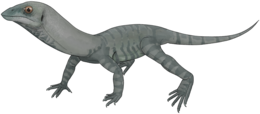Tanystropheidae is an extinct family of archosauromorph reptiles that lived throughout the Triassic Period, often considered to be "protorosaurs". They are characterized by their long, stiff necks formed from elongated cervical vertebrae with very long cervical ribs. Members of the group include both terrestrial and aquatic forms. While some tanystropheids were small lizard-like animals, other tanystropheids such as Tanystropheus were large animals that had necks that were several meters long, longer than the rest of their bodies.
| Tanystropheidae Temporal range: Triassic,
| |||
|---|---|---|---|

| |||
| Skeletal reconstruction of Tanystropheus longobardicus | |||

| |||
| Life restoration of Langobardisaurus | |||
| Scientific classification | |||
| Domain: | Eukaryota | ||
| Kingdom: | Animalia | ||
| Phylum: | Chordata | ||
| Class: | Reptilia | ||
| Clade: | Archosauromorpha | ||
| Clade: | †Tanysauria | ||
| Family: | †Tanystropheidae Gervais, 1858 | ||
| Genera[4] | |||
| |||
Tanystropheids are known from Europe, Asia (Russia, China, and Saudi Arabia), North America[5] and probably South America (Brazil).[6] The presence of tanystropheids in Europe and China indicate that they lived along much of the coastline of the Tethys Ocean.[7] However, species in western North America are found in terrestrial deposits, suggesting that as a group, tanystropheids were ecologically diverse.[5]
Relationships among tanystropheid species have been difficult to resolve because most specimens were flattened during fossilization and are preserved two-dimensionally. Three-dimensional fossils are known from Europe and North America.[5]
Phylogeny
editIn 2021, a phylogenetic study was conducted by S. Spiekman, N. Fraser, and T. Scheyer in an attempt to clarify the systematics of "protorosaur" groups. A total of 16 individual trees were found using different character scoring methods and unstable OTU exclusions. The following cladogram shows the results of analysis 3A. In this analysis, ratio and ordered characters are treated as such, and 5 out of 40 OTUs (Macrocnemus obristi, Elessaurus gondwanoccidens, Tanytrachelos ahynis, Tanystropheus “conspicuus”, and Raibliania calligarisi) are pruned after the analysis to minimize polytomies:[8]
| Archosauromorpha |
| ||||||||||||||||||||||||||||||
A later 2024 study grouped Tanystropheidae along with Trachelosauridae in the new clade Tanysauria.[9]
References
edit- ^ Wang, W.; Spiekman, S. N. F.; Zhao, L.; Rieppel, O.; Scheyer, T. M.; Fraser, N. C.; Li, C. (2023). "A new long-necked archosauromorph from the Guanling Formation (Anisian, Middle Triassic) of southwestern China and its implications for neck evolution in tanystropheids". The Anatomical Record. doi:10.1002/ar.25216. PMID 37029530. S2CID 258028261.
- ^ Lu, Y.-T.; Liu, J. (2023). "A new tanystropheid (Diapsida: Archosauromorpha) from the Middle Triassic of SW China and the biogeographical origin of Tanystropheidae". Journal of Systematic Palaeontology. 21 (1). Bibcode:2023JSPal..2150778L. doi:10.1080/14772019.2023.2250778. S2CID 263634664.
- ^ a b Adam C. Pritchard; Hans-Dieter Sues (2019). "Postcranial remains of Teraterpeton hrynewichorum (Reptilia: Archosauromorpha) and the mosaic evolution of the saurian postcranial skeleton". Journal of Systematic Palaeontology. 17 (20): 1745–1765. Bibcode:2019JSPal..17.1745P. doi:10.1080/14772019.2018.1551249. S2CID 91446492.
- ^ Fossilworks
- ^ a b c Pritchard, Adam C; et al. (2015). "Late Triassic tanystropheids (Reptilia, Archosauromorpha) from northern New Mexico (Petrified Forest Member, Chinle Formation) and the biogeography, functional morphology, and evolution of Tanystropheidae". Journal of Vertebrate Paleontology. 35 (2): e911186. Bibcode:2015JVPal..35E1186P. doi:10.1080/02724634.2014.911186. S2CID 130089407.
- ^ Tiane Macedo De Oliveira; Daniel Oliveira; Cesar L. Schultz; Leonardo Kerber; Felipe L. Pinheiro (2018). "Tanystropheid archosauromorphs in the Lower Triassic of Gondwana". Acta Palaeontologica Polonica. 63 (4): 713–723. doi:10.4202/app.00489.2018.
- ^ Rieppel, O.; Jiang, D. Y.; Fraser, N. C.; Hao, W. C.; Motani, R.; Sun, Y. L.; Sun, Z. Y. (2010). "Tanystropheus cf. T. Longobardicus from the early Late Triassic of Guizhou Province, southwestern China". Journal of Vertebrate Paleontology. 30 (4): 1082. Bibcode:2010JVPal..30.1082R. doi:10.1080/02724634.2010.483548. S2CID 86315078.
- ^ Spiekman, S. N. F.; Fraser, N. C.; Scheyer, T. M. (2021). "A new phylogenetic hypothesis of Tanystropheidae (Diapsida, Archosauromorpha) and other "protorosaurs", and its implications for the early evolution of stem archosaurs". PeerJ. 9: e11143. doi:10.7717/peerj.11143. PMC 8101476. PMID 33986981.
- ^ Spiekman, Stephan N. F.; Ezcurra, Martín D.; Rytel, Adam; Wang, Wei; Mujal, Eudald; Buchwitz, Michael; Schoch, Rainer R. (2024-03-15). "A redescription of Trachelosaurus fischeri from the Buntsandstein (Middle Triassic) of Bernburg, Germany: the first European Dinocephalosaurus-like marine reptile and its systematic implications for long-necked early archosauromorphs". Swiss Journal of Palaeontology. 143 (1): 10. doi:10.1186/s13358-024-00309-6. ISSN 1664-2384.